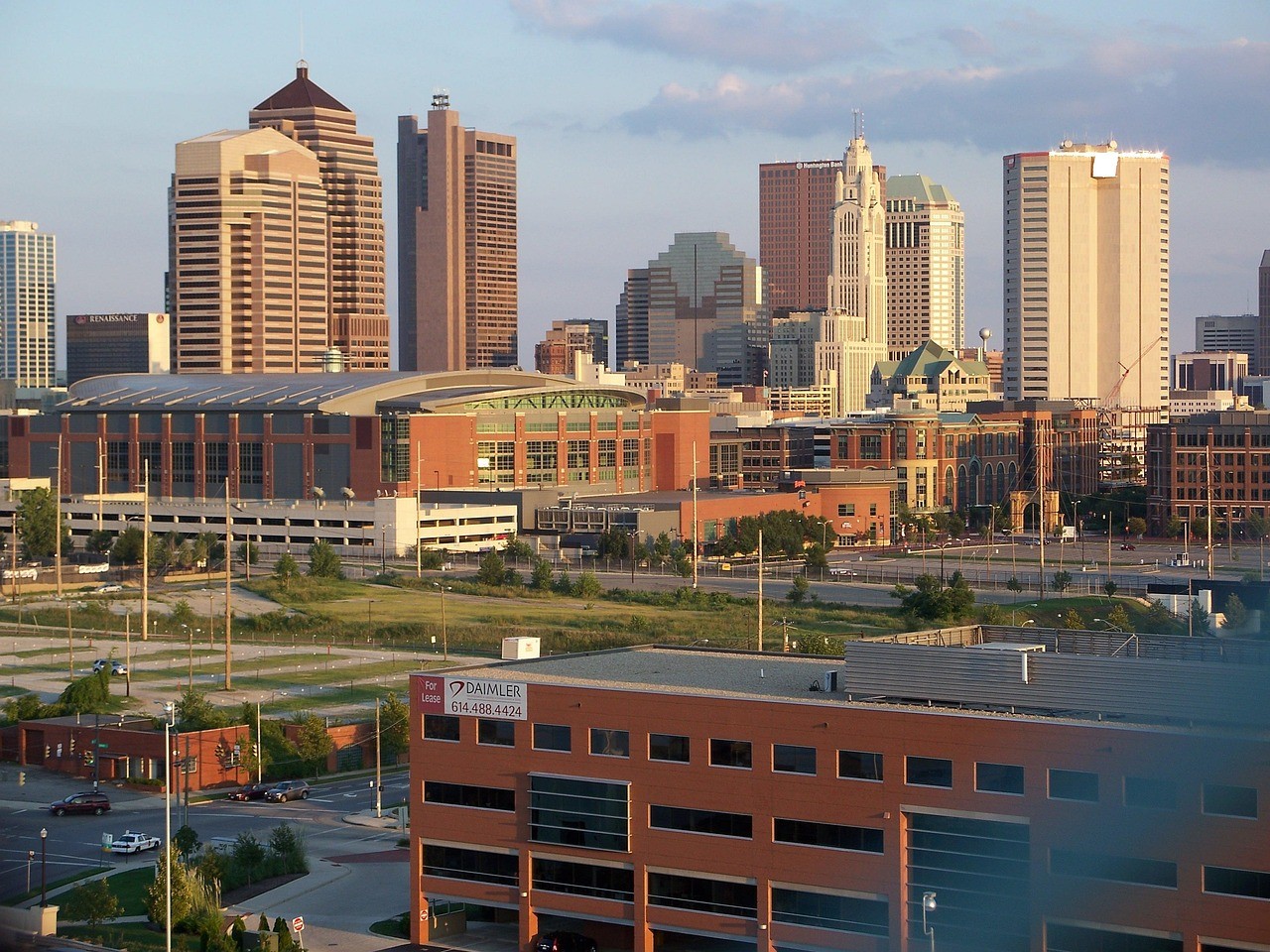
Columbus
OH
Columbus, Ohio Process Automation Experts
Transform your Columbus business with AI automation. Serving 917,000+ residents and 91,000+ businesses across Downtown, Short North, German Village. Save 65% on operations with proven automation solutions.
Columbus Success Stories: 66% Cost Reduction
Columbus businesses using our AI automation services report 66% cost reduction. From Private GPT deployments to agentic workflows and intelligent chatbots, we're transforming how Columbus companies operate.
Serving Columbus's Diverse Business Community
From cutting-edge technology to diverse industries, Columbus businesses face unique challenges that demand innovative automation solutions.
Why Columbus Businesses Choose Humming Agent AI
Local Columbus Presence
We understand Columbus business needs. Our local team provides rapid response and tailored solutions specifically for your market.
Rapid Response Time
With our 45min response time in Columbus, we're here when you need us. No waiting for Silicon Valley support teams.
Ohio-Sized Value
We understand Columbus business economics. Our solutions deliver enterprise-level AI at prices that make sense for local companies.
Quick Columbus Stats
Explore Columbus
See the vibrant business community and beautiful cityscape where we're proud to serve local businesses with AI automation solutions.

Photo from Pixabay

Photo from Pixabay

Photo from Unsplash

Photo from Pixabay

Photo from Pixabay

Photo from Pexels
6 images of Columbus • Click to view larger
ROI for Columbus Businesses
Real savings based on Columbus's local market conditions
Columbus Business Automation Overview
Columbus, Ohio stands as the heartbeat of Central Ohio with 917,679 residents and an estimated 91,767 businesses serving the fastest-growing metropolitan area in the Midwest.
Home to five Fortune 500 companies including Cardinal Health (#14 nationally with $226.8 billion revenue), Nationwide Insurance (#75 with $58.6 billion revenue), American Electric Power, Huntington Bank, and Bath & Body Works, Columbus represents a $147 billion economy driven by diverse industries from government and education to healthcare and logistics.
With 324,000 professional services jobs, 288,000 government positions, and 270,000 healthcare and education roles, Columbus businesses face unprecedented opportunities to leverage automation for competitive advantage in an increasingly digital marketplace.
The Columbus metropolitan area's remarkable 1.38% year-over-year growth rate, adding 30,348 new residents in 2024 alone, creates both tremendous opportunities and operational challenges for local businesses.
As Ohio's capital and largest city, Columbus serves as a testing ground for Fortune 500 innovation while supporting thousands of small and medium enterprises across iconic neighborhoods like Downtown, Short North Arts District, German Village, Easton Town Center, and the Brewery District.
Current economic trends show strong recovery with unemployment at historic lows of 3.0%, yet businesses struggle with labor shortages, rising operational costs, and the need to serve an increasingly sophisticated customer base expecting 24/7 digital experiences.
Major employers including Ohio State University (47,000+ employees), Cardinal Health (8,660 employees), Honda (8,850 employees), Nationwide Insurance (16,000 employees), and Huntington Bank (5,741 local employees) create a competitive labor market driving wages well above Ohio's $10.70 minimum wage.
Professional services roles average $35-55 per hour, while administrative positions command $20-30 per hour including benefits and overhead.
This wage inflation, combined with Columbus's rapid economic expansion and Intel's $20 billion semiconductor investment attracting thousands more workers, makes business automation essential for maintaining profitability while delivering superior customer experiences that drive growth in Central Ohio's dynamic marketplace.
Industry-Specific Automation Solutions
Tailored solutions for Columbus's key business sectors
Healthcare
307 words of industry-specific insights
and Life Sciences
Local Presence
Specific Challenges
Automation Opportunities
ROI Calculation
Healthcare administrative staff earn $35.75 per hour including benefits totaling $74,360 per full-time equivalent annually.
Automation reduces manual processing costs to $22,308, saving $52,052 per position annually (70% reduction).
A 200-bed hospital typically saves $2.6 million yearly while improving patient satisfaction scores by 35% and reducing medical errors by 50% through consistent automated protocols and documentation.
Success Example
Financial
336 words of industry-specific insights
and Insurance
Local Presence
Specific Challenges
Automation Opportunities
ROI Calculation
Financial services representatives earn $31.25 per hour including benefits totaling $65,000 per full-time equivalent annually.
Automation reduces service costs to $19,500, saving $45,500 per position annually (70% reduction).
A mid-size Columbus financial firm typically reduces operational costs by $910,000 yearly while improving customer response times by 90% and increasing client satisfaction scores significantly through 24/7 availability and consistent service quality.
Success Example
Columbus Business Districts
DOWNTOWN COLUMBUS BUSINESS DISTRICT
Downtown Columbus encompasses the central business district within the I-670/I-71 inner belt, housing Ohio's state government operations, major corporate headquarters including Nationwide Insurance and Huntington Bank, and over 125,000 daily workers creating the largest concentration of professional services in Central Ohio.
The area features dense concentrations of legal firms, accounting practices, consulting companies, and government contractors serving both public and private sector clients across multiple industries.
Business automation opportunities abound in professional services where document-heavy workflows, client communication management, and compliance reporting create significant efficiency gains that directly impact profitability.
The Columbus Commons and Scioto Mile development attract retail and hospitality businesses requiring automated customer service, inventory management, and point-of-sale integration to handle high-volume tourist and business visitor traffic.
Downtown's 24/7 operational demands make automation essential for maintaining competitive service levels while managing labor costs in Ohio's highest-wage employment district.
SHORT NORTH ARTS DISTRICT
The Short North Arts District along High Street represents Columbus's creative and entrepreneurial hub, home to over 300 independent businesses including art galleries, boutique retailers, specialty restaurants, and creative services firms serving both local residents and regional customers.
This neighborhood's diverse business ecosystem benefits significantly from automation technologies addressing common small business challenges like inventory management for unique artisan products, social media marketing automation for galleries and studios, and customer relationship management for service-based businesses requiring personalized attention.
Restaurant automation opportunities include online ordering systems, reservation management, and automated marketing campaigns that maintain the district's personal character while improving operational efficiency.
The area's strong tourism component creates demand for multilingual customer service automation and event management systems handling monthly Gallery Hop events and seasonal festivals.
Small business owners in the Short North typically achieve 40-60% operational cost reductions through strategic automation implementation while preserving the authentic, creative atmosphere that attracts customers.
GERMAN VILLAGE HISTORIC DISTRICT
German Village's historic charm attracts boutique businesses, specialty restaurants, and professional services housed in restored 19th-century buildings creating unique operational challenges for modern businesses maintaining historic character while implementing contemporary automation solutions.
The neighborhood's 233-acre historic district includes over 1,600 buildings creating opportunities for businesses that blend traditional craftsmanship with modern efficiency through automation.
Local businesses benefit from automated systems handling tourist inquiries, managing seasonal visitor fluctuations, and coordinating with historic preservation requirements while maintaining the personal service quality that defines the German Village experience.
Restaurant and retail businesses implement point-of-sale automation, inventory management systems, and customer loyalty programs generating average revenue increases of 25-35% while preserving the neighborhood's authentic German heritage and artisan character.
Professional services firms located in converted historic buildings rely on cloud-based automation solutions providing modern capabilities while respecting architectural constraints and historic preservation guidelines.
EASTON TOWN CENTER COMMERCIAL HUB
Easton Town Center represents Columbus's premier mixed-use development with over 200 retail stores, 30+ restaurants, entertainment venues, and corporate offices creating a concentrated business environment serving 25+ million annual visitors from throughout Central Ohio and neighboring states.
The area's retail concentration creates significant automation opportunities including inventory management systems coordinating across multiple brand locations, customer service chatbots handling high-volume inquiries, and automated marketing campaigns driving traffic during peak shopping periods and special events.
Corporate tenants including Express headquarters, Limited brands, and numerous regional offices implement comprehensive business process automation reducing operational costs by 45-65% while improving customer service quality and employee productivity.
The entertainment district's bars, restaurants, and venues benefit from automated reservation systems, event management platforms, and customer communication tools handling high-volume operations efficiently while maintaining service quality during peak periods and special events throughout the year.
BREWERY DISTRICT ENTERTAINMENT CORRIDOR
The Brewery District south of Downtown showcases Columbus's entertainment and hospitality sector with numerous bars, restaurants, event venues, and emerging tech companies occupying converted brewery buildings that blend industrial architecture with modern business operations.
This neighborhood's nightlife focus creates unique automation requirements including crowd management systems, automated marketing for events and promotions, and customer service solutions handling high-volume weekend operations while maintaining safety and service quality.
Local businesses implement automated social media management, online ordering systems, and inventory tracking reducing labor costs by 35% while improving customer experiences through faster service and personalized marketing.
The district's growing tech startup presence drives demand for comprehensive business automation solutions helping new companies scale operations efficiently from day one while competing with established Columbus businesses for talent and customers in the rapidly evolving technology sector.
Seasonal Business Patterns
### Columbus Climate and Business Cycles
Columbus experiences a humid continental climate with distinct seasons significantly impacting business operations throughout the year, requiring flexible automation systems that adapt to changing demand patterns and operational requirements.
Winter temperatures averaging 30°F create increased demand for indoor entertainment, restaurant delivery services, and retail shopping driving automation needs for inventory management, customer service, and logistics coordination that maintain service quality during weather challenges.
Spring weather averaging 60°F brings increased outdoor activities, home improvement projects, and event planning requiring automated scheduling systems, customer communication platforms, and project management tools that capitalize on seasonal business opportunities while managing capacity efficiently.
Summer temperatures reaching 85°F peak tourism at attractions like the Columbus Zoo, German Village tours, and outdoor festivals necessitating automated visitor management, multilingual customer service, and capacity planning systems that handle visitor surges while maintaining quality experiences.
Fall season brings Ohio State football generating massive economic impact with 105,000-capacity Ohio Stadium creating 8-10 weekends of concentrated business activity requiring automated traffic management, restaurant reservation systems, hotel booking platforms, and retail inventory optimization handling 300% normal volume increases while maintaining service quality and customer satisfaction.
ROI & Cost Analysis
### Current Labor Market Analysis
Columbus businesses face rising labor costs with Ohio's minimum wage at $10.70 per hour in 2025, significantly above the federal $7.25 rate, while Columbus's competitive job market drives actual wages substantially higher across all skill levels.
Professional services roles average $35-55 per hour, administrative positions range $20-30 per hour, customer service representatives earn $16-22 per hour, and specialized technical roles command $30-45 per hour reflecting the city's skilled workforce and competitive employment market.
When including mandatory benefits (Social Security 7.65%, unemployment insurance 2.5%, workers compensation 1.2%), voluntary benefits (health insurance, retirement contributions averaging 25% of wages), and overhead costs (office space, equipment, training averaging 35% of total compensation), true employment costs reach 165% of base wages creating significant cost pressures for growing businesses.
The arrival of Intel's $20 billion semiconductor manufacturing investment and expansion of existing major employers including Cardinal Health, Nationwide Insurance, and Ohio State University creates intense competition for skilled workers driving wages even higher.
Administrative roles that previously paid $18-22 per hour now command $22-28 per hour, while customer service positions have increased from $14-16 per hour to $16-20 per hour, reflecting Columbus's economic growth and tight labor market conditions that make automation particularly valuable for cost control and operational efficiency.
Implementation Roadmap
Your strategic path to successful business automation in Columbus
Assessment and Strategy (Weeks 1-4)
What happens in this phase:
Pilot Program Development (Weeks 5-12)
What happens in this phase:
Full-Scale Deployment (Weeks 13-24)
What happens in this phase:
Ready to transform your Columbus business?
Columbus Success Stories
Local Success Story
German Village Restaurant Chain Automation
A family-owned restaurant group operating four locations across German Village and the Brewery District implemented comprehensive automation addressing seasonal tourism fluctuations, Ohio State football weekend surges, and labor shortage challenges affecting Columbus hospitality businesses.
Prior to automation, restaurants struggled with inconsistent service during peak periods when customer volume increased 300% while staff availability decreased due to student employees' class schedules and seasonal employment patterns affecting service quality and profitability.
Automation implementation included online reservation systems with intelligent table management optimizing seating efficiency, automated inventory ordering based on predictive analytics accounting for weather patterns and OSU football schedules, customer communication platforms sending personalized promotions and event notifications, point-of-sale integration streamlining order processing and payment handling, and integration with local tourism data predicting visitor patterns enabling proactive staffing and inventory adjustments for optimal service delivery.
Results included 85% reduction in wait times during peak periods improving customer satisfaction and table turnover, 60% increase in table turnover efficiency maximizing revenue during high-demand periods, 40% improvement in customer satisfaction scores measured through online reviews and feedback, and $125,000 annual savings in labor costs while serving 35% more customers through operational efficiency gains.
The restaurant group owner noted, "Automation allowed us to maintain our German Village charm while providing modern convenience our customers expect, making us the top-rated restaurant group in the district."
Compliance & Regulations
### Ohio State Data Privacy Requirements
Columbus businesses implementing automation must comply with Ohio's comprehensive data breach notification laws requiring notification within reasonable time when personal information may be compromised, including specific procedures for notifying affected individuals, law enforcement, and relevant regulatory agencies.
Ohio Revised Code Section 1347.12 mandates specific security measures for businesses handling personal information including encryption requirements, access controls, audit trail maintenance, and incident response procedures that must be incorporated into automation systems.
Automated systems must include comprehensive audit trails, data retention policies aligned with Ohio state requirements, secure data disposal methods meeting regulatory standards, and privacy controls protecting sensitive information throughout processing and storage.
Business automation platforms require compliance with Ohio consumer protection laws including automatic renewal restrictions, clear cancellation policies, transparent pricing disclosures, and consumer rights notifications that must be integrated into automated customer communications and billing systems.
Healthcare automation must meet HIPAA requirements plus Ohio-specific medical privacy regulations enforced by state agencies, while financial services automation requires compliance with Ohio Division of Financial Institutions regulations, federal oversight agencies, and specific requirements affecting credit unions and regional banks headquartered in Columbus.
Success Metrics & KPIs
### Operational Performance Improvements
Columbus businesses implementing comprehensive automation typically achieve 65-75% reduction in manual processing time, 90% improvement in task accuracy eliminating costly errors, and 40% increase in customer satisfaction scores through faster response times and consistent service quality.
Service response times improve from average 24-48 hours to under 2 hours for routine inquiries, while complex issues requiring human intervention are handled more efficiently through automated information gathering and case routing to appropriate specialists.
Error rates decrease by 85% through automated quality control systems eliminating human mistakes in data entry, calculation processes, routine communications, and compliance documentation that previously required costly corrections and customer service recovery efforts.
Productivity metrics show 150% increase in daily transaction processing capacity with existing staff, 200% improvement in multi-tasking efficiency as employees focus on high-value activities, and 300% enhancement in peak period handling capability during Ohio State football games, seasonal shopping surges, and special events requiring rapid capacity scaling.
Competitive Advantage
### Traditional Staffing Cost Disadvantages
Columbus businesses relying on traditional staffing face escalating costs with Ohio minimum wage increases, competitive labor market driving wage premiums above state minimums, and comprehensive benefits packages required for talent retention in competition with major employers including Cardinal Health, Nationwide Insurance, Ohio State University, and incoming Intel semiconductor operations.
Turnover costs average $18,000-28,000 per position including recruiting expenses, background checks, training time, productivity loss during transition periods, and opportunity costs from delayed customer service and project completion.
Seasonal staffing challenges require temporary agencies charging 150-200% premium rates during peak periods including Ohio State football season, holiday shopping, summer festivals, and tax season creating budget volatility and reduced profitability during high-revenue periods.
Traditional staffing limitations include fixed working hours restricting customer service availability to business hours, human error rates averaging 5-8% in manual processes creating costly corrections, productivity variations based on individual performance and motivation levels, and inability to scale rapidly for peak demand periods without expensive overtime and temporary labor costs.
Frequently Asked Questions
How does business automation work specifically for Columbus companies?
What Columbus neighborhoods benefit most from automation?
Can automation handle Ohio State football game day traffic spikes?
How does automation comply with Ohio data privacy laws?
What's the typical ROI for Columbus businesses implementing automation?
Does automation work with Columbus city business licensing requirements?
How does automation handle seasonal hiring for Columbus businesses?
Can small German Village shops benefit from business automation?
What automation works best for Columbus healthcare providers?
How does automation integrate with Ohio State University research partnerships?
Does automation work during Columbus winter weather disruptions?
How quickly can Columbus businesses implement automation?
What training is required for Columbus employees using automation?
Can automation handle Columbus municipal compliance requirements?
How does automation benefit Columbus logistics and distribution companies?
What makes Columbus businesses ideal candidates for automation?
Does automation work with Columbus's Fortune 500 company supply chains?
How does automation support Columbus tourism and hospitality businesses?
Can automation handle Columbus's diverse business regulatory environment?
What ongoing support is available for Columbus businesses using automation?
How does automation help Columbus businesses compete regionally?
Does automation work for Columbus startups and growing companies?
How does automation enhance Columbus's reputation as a business-friendly city?
Can automation integrate with Columbus area manufacturing operations?
What cybersecurity protections are included with Columbus business automation?
Strategic Implementation Timeline
Columbus businesses face unprecedented opportunities in 2025 with continued metropolitan growth, increasing customer expectations, and competitive pressures requiring operational excellence for sustained success. The city's position as Ohio's capital, home to five Fortune 500 companies, and the Midwest's fastest-growing metropolitan area creates ideal conditions for businesses to leverage automation for competitive advantage while controlling costs in an increasingly expensive labor market. Don't let manual processes limit your growth potential while competitors gain market share through superior customer experiences and operational efficiency that automation provides.
Our comprehensive automation solutions are specifically designed for Columbus market conditions including seasonal variations from OSU football to summer tourism, regulatory requirements unique to Ohio's capital city, and integration capabilities with local business ecosystems including major employers' systems and regional service providers. Whether your business operates in Downtown's corporate district, the Short North's creative economy, German Village's tourism market, or the Easton area's retail concentration, automation provides immediate benefits and long-term competitive advantages that drive growth and profitability in Central Ohio's dynamic business environment.
Schedule your complimentary Columbus business automation consultation today to discover how our solutions can reduce your operational costs by 50-70%, improve customer satisfaction by 35-50%, and position your business for sustained growth in Central Ohio's dynamic economy. Implementation can begin within two weeks with immediate benefits visible throughout the process, enabling your business to compete effectively with Fortune 500 companies while maintaining the personalized service that defines Columbus's business community. Transform your Columbus business operations and join the automated economy leading Ohio's economic future.
Get Your Free Columbus AI Strategy Session
Discover how AI automation can transform your Ohio business with a personalized consultation
No credit card required • 30-minute consultation • Immediate value
Proudly Serving All Columbus Area
Complete coverage across Columbus and surrounding communities with local expertise in every neighborhood
Rapid Response
45-minute average response time across all Columbus neighborhoods
Local Teams
On-ground support available for in-person consultations
Trusted Partner
Serving 100+ businesses with proven results
Ready to Join 100+ Columbus Businesses Saving with AI?
Schedule a free consultation at your Columbus office or via video call. We'll show you exactly how much you can save.
Got Questions?
We've Got Answers
Everything Columbus business owners need to know about transforming their operations with AI automation
Most Columbus businesses are up and running with their AI agent within 48 hours. Our local team provides rapid deployment and on-site training if needed. We understand the fast-paced business environment in Ohio and prioritize quick implementation.
Still have questions? We're here to help!
Why Columbus Businesses Choose Humming Agent
As a Columbus business owner, you need automation solutions that understand your local market, regulations, and customer base. Our team combines deep local expertise with cutting-edge AI technology to deliver results that matter.
In today's competitive Columbus market, businesses need every advantage they can get. Our AI automation platform provides that edge by handling routine tasks, qualifying leads, scheduling appointments, and providing instant customer support - all while you focus on growing your business.
We're not just another tech company. We understand the unique challenges facing Columbusbusinesses, from seasonal fluctuations to local competition. Our solutions are designed specifically to address these challenges and help you thrive in the Ohio market.
The Columbus Advantage
Ready to Transform Your Columbus Business?
Join 50+ Columbus businesses already saving with AI
AI Automation in Nearby Cities
We also provide comprehensive AI automation services in these nearby locations:
Transform Columbus Today
Free consultation available